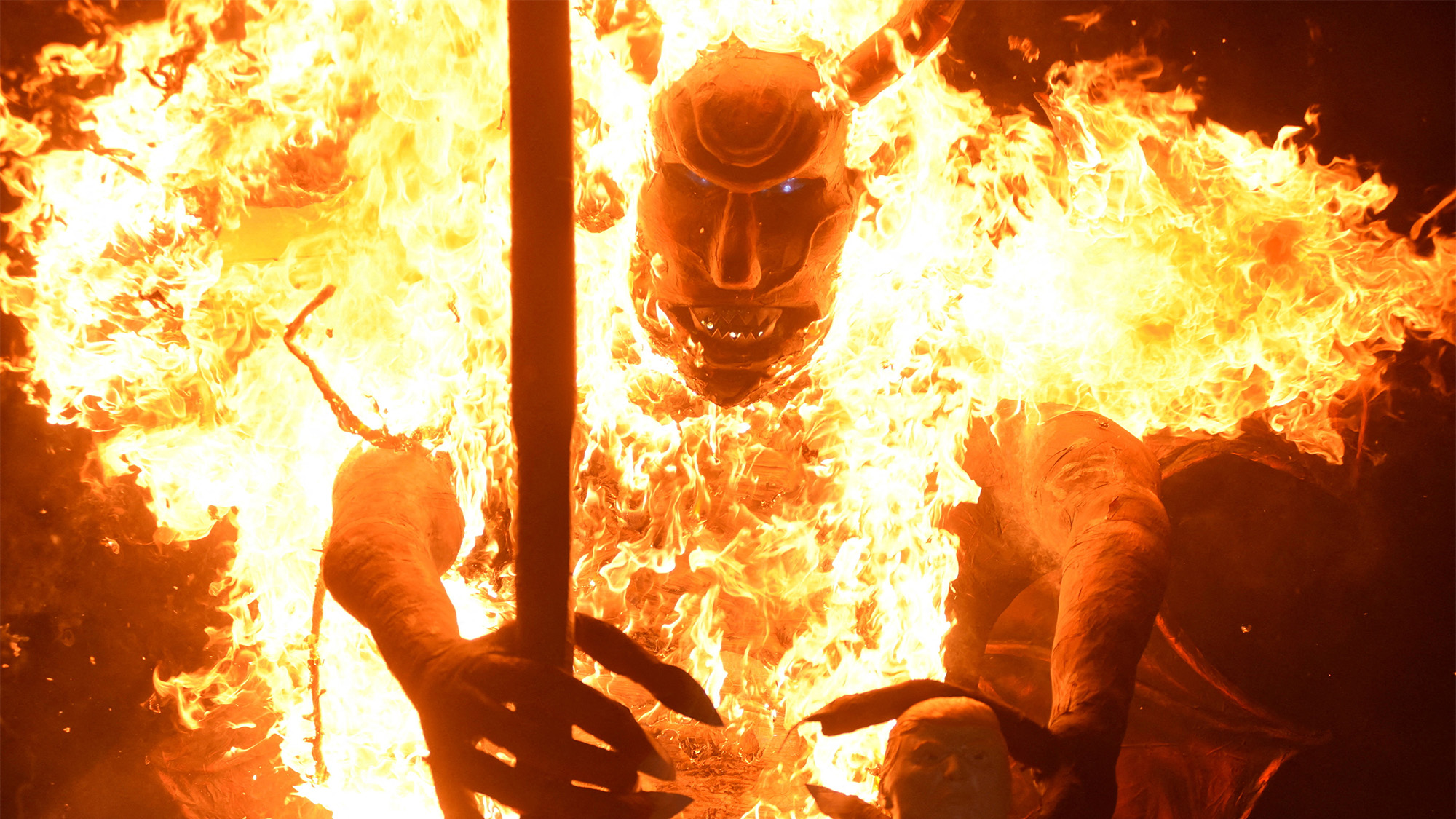Remembering the crew of space shuttle Columbia
The seven brave astronauts who perished in last week’s shuttle disaster leave behind friends, family, and lives full of enormous achievement.
Ilan Ramon 1954–2003
Col. Ilan Ramon, the first Israeli astronaut, carried into space a stark black-and-white drawing made by a 14-year-old Jewish boy in a Nazi concentration camp. In Moon Landscape, young Peter Gantz’s imagination soared far beyond the camp’s barbed-wire fence to the mountains of the moon, where he could safely view the Earth, floating majestically in space. Ramon, a national hero in Israel and the son of a Holocaust survivor, said the drawing would connect his mission on Columbia to all those who died in the Holocaust—and to all of Israel, a nation of survivors. “I feel I’m representing all Jews,” Ramon told the Israeli newspaper Ha’aretz. The drawing and a Torah scroll he brought aloft, he said, symbolize, “more than anything, the ability of the Jewish people to survive everything, including horrible periods, and go from the darkest days to days of hope and faith in the future.” At a time of relentlessly grim news, Ramon’s mission made him an even bigger hero in Israel, where he was already celebrated for his exploits as an Air Force top gun. “Astronaut Lifts Nation’s Spirits,” said a Jerusalem Post headline last week. A veteran of both the 1973 Yom Kippur War and the 1982 war in Lebanon, Ramon, 48, was also one of eight fighter pilots who destroyed the French-built nuclear reactor near Baghdad in 1981. Days before Columbia disintegrated during re-entry, Ramon had a chat with Israeli Prime Minister Ariel Sharon that was carried live on Israeli TV. “What can you see from there that you can’t see from here?” Sharon asked. “Our Earth is beautiful, really,” Ramon answered. “We’ve got to take care of it like the apple of our eye.” He is survived by his wife, Rona, and their four children.
Dr. Laurel Blair Salton Clark 1961–2003
The Week
Escape your echo chamber. Get the facts behind the news, plus analysis from multiple perspectives.

Sign up for The Week's Free Newsletters
From our morning news briefing to a weekly Good News Newsletter, get the best of The Week delivered directly to your inbox.
From our morning news briefing to a weekly Good News Newsletter, get the best of The Week delivered directly to your inbox.
A bagpipe rendition of “Amazing Grace” was Dr. Laurel Blair Salton Clark’s wake-up call aboard Columbia. Proud of her Scottish heritage, she also requested the song at her wedding to fellow Navy officer Jonathan Clark. Growing up, Clark had dreamed of becoming a veterinarian, but after majoring in zoology at the University of Wisconsin in Madison, she opted instead for the university’s medical school. Just before graduating from college, she and five friends sailed a 42-foot boat through the Virgin Islands. Other passions included scuba diving, mountain biking, hiking, rock climbing, and parachuting, though she gave up sky diving after her son Iain was born eight years ago. To pay for medical school, Clark joined the Navy, hoping to become a pediatrician after she fulfilled her military obligation. Instead, she developed a passion for undersea medicine, specializing in the treatment of ailing submarine personnel. Later she served as a flight surgeon, with postings in Pensacola, Fla.; Holy Loch, Scotland; and Yuma, Ariz. After a decade in the service, she applied to become an astronaut at a friend’s suggestion, “though she was not accepted on the first round,” said The New York Times. “She later became part of a class known as the Sardines, because it had more than 40 astronaut candidates, the most in history.” On board the shuttle, Clark, 41, conducted a variety of experiments, including the effect of gravity on fire, heart and lung functions, and the growth of prostate cancer cells. “I have seen some incredible sights,” she e-mailed home: “lightning spreading over the Pacific, the aurora australis lighting up the entire visible horizon with the city glow of Australia below, the crescent moon setting over the limb of the Earth, the vast plains of Africa and the dunes on Cape Horn, rivers breaking through tall mountain passes.” At her funeral, the congregation sang “Amazing Grace.”
David M. Brown 1956–2003
David M. Brown, M.D., was doing his internship at a South Carolina hospital when a Navy brochure changed his life. The cover showed a Navy physician standing on a flight deck next to an F-4 Phantom. “Boy, I’ve got to go learn about this,” he said to himself. Enlisting as soon as he finished his medical training, he was assigned to the USS Carl Visson in the western Pacific Ocean. Brown had first dreamed of flying when, as a 13-year-old boy, a friend took him for a ride in a small plane. Flying remained a passion even while he studied for his degree at Eastern Virginia Medical School in Norfolk. Not only did he take flying lessons, but he built several small airplanes as a hobby. He also had a whimsical side, joining Circus Kingdom one summer to perform as an acrobat, stilt walker, and 7-foot unicyclist. But once he joined the Navy, his love of flying deepened. In 1988 he was chosen for pilot training, flying F-18 Hornet jet fighters and A-6E Intruder attack aircraft. In 1996 NASA selected him as an astronaut, with a specialty in medicine and biology. A bachelor, the 46-year-old Brown had taken with him as he soared into orbit a flag from Yorktown High School in Arlington, Va., the same one another graduate had taken up Mount Everest. Before making his first space flight, Brown said, “I’m going to get it a little bit higher up, but I won’t have to walk as far to get it there.”
Rick Husband 1957–2003
A free daily email with the biggest news stories of the day – and the best features from TheWeek.com
From 200 miles above Earth, the commander of Columbia took a moment last week to remember the men and women who lost their lives on Apollo 1 and Challenger. “Their dedication and devotion to the exploration of space was an inspiration,” said Col. Rick Husband, 45. Husband had dreamed of being an astronaut since he was a 4-year-old boy staring through a telescope in his Amarillo, Texas, bedroom, said the Amarillo Globe-News. Husband traced his fascination with flight to his father, a Navy pilot. After college, he went into the Air Force, where he logged 3,800 hours in more than 40 types of aircraft. When Husband was turned down by NASA, he simply applied again. And again. And again. He finally made it to space on the shuttle Discovery in 1999, but his friends inevitably described him as “down-to-earth.” A devout Christian, Husband’s rich baritone often dominated his church choir. “Just being able to sing a song to tell God how much I love him, it just feels great,” he said. His favorite moments were those spent with his wife, Evelyn, and his two young children, Laura and Matthew. He especially treasured tucking the kids into bed and singing them to sleep. “I wouldn’t trade any of those things for a ride in space,” said Husband, “because it wouldn’t be worth it.”
Michael Anderson 1959–2003
As a boy in Spokane, Michael Anderson always wore goggles when mowing the lawn. An eye injury, he knew, would ruin his chances of becoming an astronaut. “You don’t very often see kids with such drive, but he had it,” said Anderson’s high school science teacher. Anderson’s imagination was fueled by the sci-fi fantasies of Star Trek and Lost in Space, while his analytical mind earned him multiple degrees in physics and astronomy. He followed his father into the Air Force, and in 1994 became one of NASA’s few African-American astronauts. Lt. Col. Anderson had two daughters, and was proud to be a role model to black children in his overwhelmingly white hometown. His former Sunday-school teacher keeps on display a signed photo of Anderson in his spacesuit to inspire the next generation to follow their dreams. Anderson, 43, was Columbia’s payload commander, in charge of its science experiments. He made his first trip into space in 1998, delivering supplies to the accident-plagued Mir space platform. The Mir crew’s perseverance in the face of near-fatal disasters impressed Anderson immensely. “We are going to have accidents. We are going to have things happen that we didn’t plan on,” he said. “If we’re going to be serious about exploring space, then we’re going to have to have the resolve that the Russians showed here.”
Kalpana Chawla 1961–2003
An avid scientist, Dr. Kalpana Chawla was as captivated by the poetry of space travel as by its physics. She first flew on Columbia in 1997, and was haunted by the view of Earth the shuttle offered when she climbed into her “bed,” facing a round window. “In the pre-sleep period, when you’re looking out the window, you’re floating,” she recalled. “You see the continents go by, the thunderstorms shimmering in the clouds, the city lights at night…Earth is very beautiful—I wish everyone could see it.” It was a view that Chawla, 41, had no reason to expect she’d ever see while growing up in India, said the Chicago Tribune. Her “journey from small-town India was little short of remarkable.” The youngest daughter of a middle-class Indian family, she was expected simply to await her turn for an arranged marriage. Instead, the energetic tomboy became the first female to graduate from Punjab University in aeronautical engineering. She moved to the U.S. to continue her studies, married an American pilot, and earned her own pilot’s license prior to joining NASA. Chawla took most of her friends aloft, so they, too, could see how the Earth looked from the sky. In an e-mail sent from orbit just two days before her death, she reminded Punjab University students that they could go as far as their dreams would allow. “The path from dream to success does exist,” Chawla wrote. “May you have the vision to find it, the courage to get on to it, and the perseverance to follow it. Wishing you a great journey.”
William C. McCool 1961–2003
-
 The week’s best photos
The week’s best photosIn Pictures A man's best friend, the elephants in the room, and more
-
 A TikTok trend has Gen Z men leaving streetwear behind for more preppy attire
A TikTok trend has Gen Z men leaving streetwear behind for more preppy attireThe Explainer More than a zipper: Young Black men embrace the ‘quarter-zip movement‘
-
 Codeword: December 12, 2025
Codeword: December 12, 2025The daily codeword puzzle from The Week